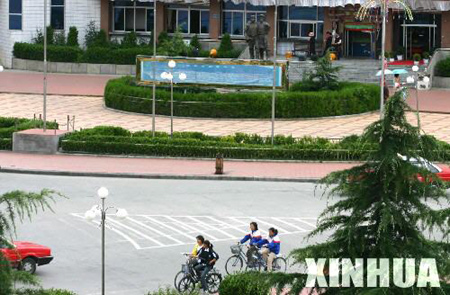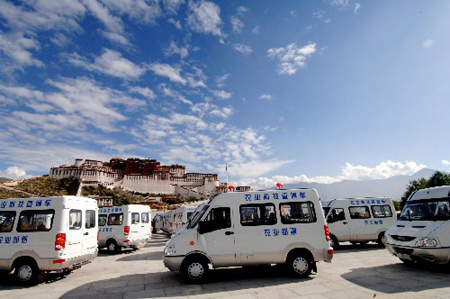Nyingchi, a small county in Tibet, boasts modern public facilities like the Guangdong Avenue, Xiamen Hotel, Fujian Park, most of them completed under the central government's aid-Tibet policy.
Since the democratic reform in 1959, the central government has implemented a series of preferential policies to speed up the development in Tibet.
Particularly since the adoption of reform and opening policies in 1979, four sessions for the Forum on Work in Tibet have been held, at which strategic decisions and deployments were made for maintaining social stability and deepening reform in Tibet.
 |
|
Photo taken on July 20, 2005 shows the first elementary school in Nyingchi of southwest China's Tibet Autonomous Region being built with the help of Foshan in Guangdong Province.(XInhua Photo) |
At the second Forum on Work in Tibet in 1984, the central government decided to make direct investment in the aid-Tibet projects, provide financial subsidies and extend the support-Tibet Work to the whole nation.
Following this forum, 43 small- and medium-sized essential projects totalling RMB480 million yuan were built with help from provinces and municipalities including Beijing, Shanghai, Jiangsu and Guangdong as well as central institutes.
These projects met the basic need of Tibet's social and economic progress at that time and were honored as "43 Pearls on the Tibetan Plateau" by the locals.
By the end of 2007, more than 3,800 officials and technicians from the provincial and central governments, large central enterprises and institutions had come to work in Tibet and the total investment from them reached 9.668 billion yuan.
|

|
|
Photo taken on July 21, 2005 shows everal students ride bikes across the Xiamen Square in Nyingchi county of southwest China's Tibet Autonomous Region, which was built under the assistance of Fujian Province.(Xinhua Photo) |
With the fund, 2,861 major projects were finished, including the Lhasa People's Hospital, Conference Center in Shannan Prefecture, Changjin Bridge in Changdu Prefecture and Art Gallery of Ali Prefecture. In years, the officials and technicians have played a major role in introducing new concepts and technology to Tibet.
Tang Yongjun, deputy director of Nyingchi Development and Reform Commission said: "I myself have benefited a lot from the aid-Tibet work. The residence community where I live was built with the aid of Guangdong Province and the school which my child attends was set up under the help of Fujian Province. Not long ago, I had an operation to remove gallstones by a surgeon who is an expert from the aid-Tibet medical team of Guangdong Province."
"When the officials and technicians arrived in Nyingchi for the first time in 1995, it was unimaginable for us what difficulties they faced: no electric lights, poor telecommunications, no highways, no food markets or lack of living necessities. They had to queue for a long time to make a phone call to their families because there were only two telephone wires in those days," he recalled.
|

|
|
The buses donated by Ministry of Agriculture to improve the regional agricultural sci-tech level set out from the square before the Potala Palace in Lhasa, capital of southwest China's Tibet Autonomous Region on Aug.7, 2006.(Xinhua/Chogo) |
But now, tremendous changes have taken place, with the overall improvement in the local traffic, water conservancy construction, education, culture, medical and health care.
Among the assistance providers, outstanding examples are the Guangdong and Fujian Provinces: their financial inputs alone amounted to 2.308 billion yuan by the end of 2008. Up to now, 337 officials and technicians from them have come to assist Nyingchi and most of them are still working at their posts. The farmers and herdsmen have gained the greatest benefits and seen the fastest growth in their living standards.
According to Tibet Development and Reform Commission, after the aid-Tibet Work started in 1995, Tibet's annual GDP growth averaged 12.9 percent by 1999, higher than the national level. And the fiscal revenue of the local government was 2.2 times the figure of 1994.
(Xinhua News Agency February 25, 2009)